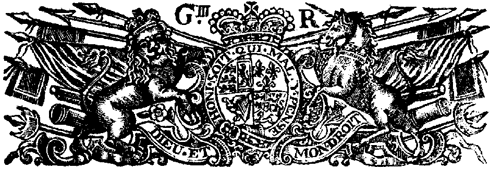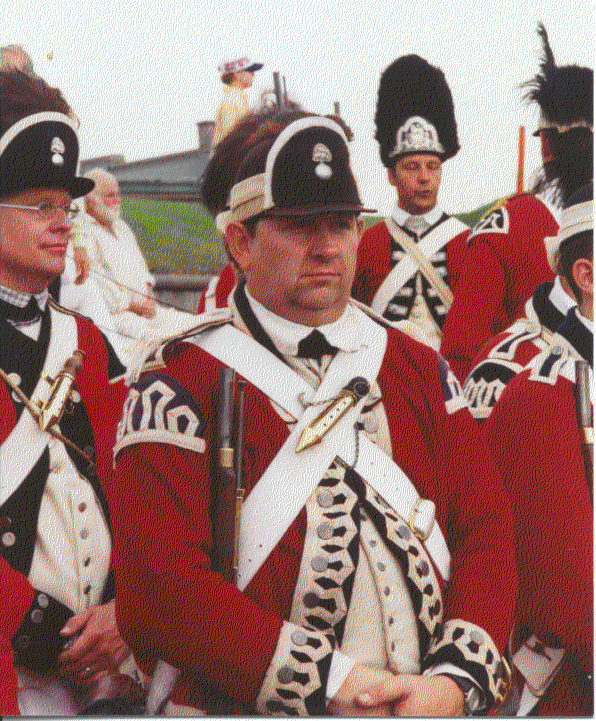

The First Foot Guards
We are a Revolutionary War
reenactment group based in Boston MA,
accurately portraying the royal household regiment that is now known as
The Grenadier Guards
The
Flank Companies:
Grenadiers
'Of the ten companies in each regiment [refers to line regiment: Guards regiments were different], one consisted of Grenadiers, and another of Light Infantry. When introduced into the army in 1677, the function of the Grenadiers had been to hurl hand grenades among the enemy's ranks at close quarters. The size and weight of these missiles demanded that the throwers be tall of structure and muscular in build. By 1775 the grenades had disappeared, but the Grenadiers remained, representing in height and strength the flower of each regiment.'
EE Curtis 'The British Army in the American Revolution' 1926.
Thus the Grenadiers were picked men, who were used much as 'shock troops'. Since
they occupied a position to the right of the Battalion, they are referred to
as a 'flank company'.

The uniform
Cap
Notice the caps that are brimless, originally because of the overarm hurling
that was necessary with a grenade. They are trimmed with bearskin. The Grenadier
in the background with brass hat plate is from a different regiment. Even though
they are brimless, they do have a peak at the front which was very useful in
aiding vision in bright sunlight.
When on parade in London, the Grenadiers would have worn the distinctive tall bearskin hat, making a big man appear even taller.
Badge
The hats carry the 'flaming grenade' badge, that later became the symbol
of the regiment when they were given the name of the Grenadier Guards.

Wings
The Grenadiers are distinguished by decorative blue shoulder pieces adorned
with lace in the regimental pattern. Old references call this adornment "looped
clothes", as in the song "The British Grenadiers" ... "who
carry caps and pouches, and wear the looped clothes/ But of all the world's
great heroes there's none that can compare... with the British Grenadiers."
"British Grenadiers" words and music
Hanger
Since the Grenadiers did not originally carry a musket, they carried a
hanger (or sword) for defense. Even after the Grenadiers had ceased to carry
grenades, the swords were retained. They were probably regarded as a mark of
honor, since officers were the only others to carry swords in 1775.
Match case
The match case on the cross-belt. This is a cylinder of brass with holes.
At the top is a plug that was attached to a length of slow match. In combat
the slow match was lit and continued to burn. It was taken out as needed to
ignite the slow match on the grenade. Originally, Grenadiers would have continually
emanated a small amount of smoke and emitted a continuous smell that today we
associate with fireworks. After grenades were no longer utilized, the match
case was retained. Extra brightwork for the Grenadiers to polish, to make them
the smart body of men that they are.
The grenade was simply a small hollow cannonball, filled with bullets and powder. A hole in it admitted a slow match (or fuse), which passed through a wooden plug. Grenades had much the appearance of a classic cartoon 'bomb'. The grenadier cut then ignited the slow match. This was a skilled procedure: too much fuse and the grenade might be hurled back at them, too little and the grenade would explode prematurely. Grenades were originally carried in a grenade pouch slung from the left shoulder, crossing the body. In our time period, they have been replaced by cartridge boxes.

The picture above
shows two grenadiers.
A private soldier on the right, and a Serjeant Major (Grenadiers) on the left.
The Serjeant Major has two gold epaulettes, and a red sash about the waist.
He is wearing white breeches and gaiters. He shoulders his musket on the right
shoulder (unlike the Private Soldiers), and his firelock is a version of the
musket that has a shorter barrel, called a fusil.
Go to
"Companies" page
Click